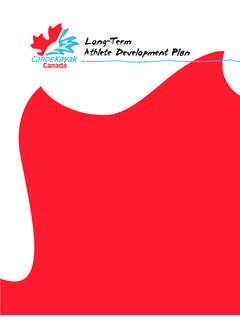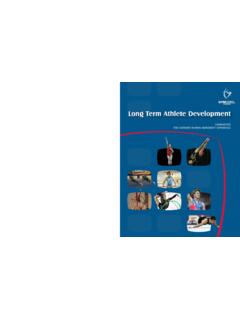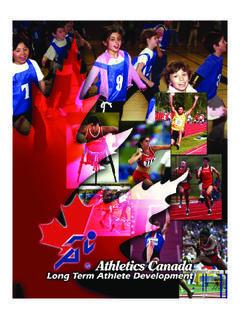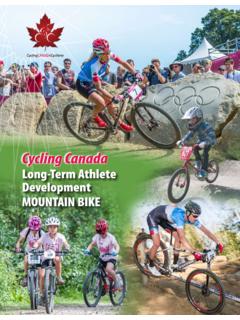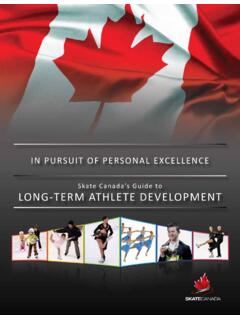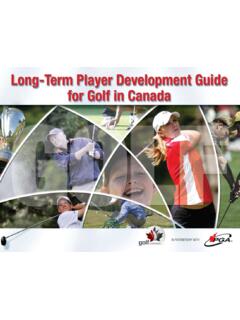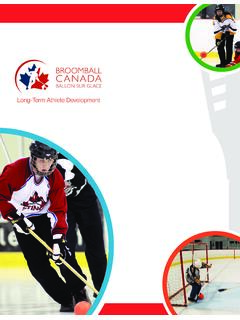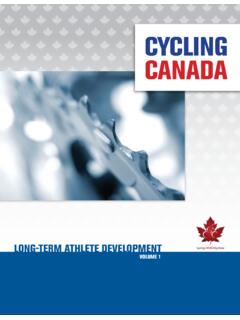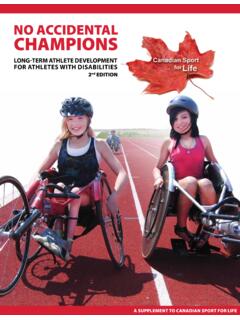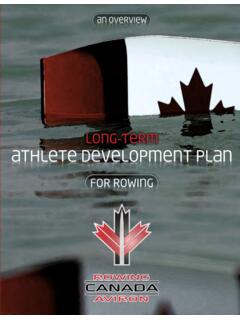Transcription of Sport System Building and Long-term Athlete Development …
1 Page 1 Sport System Building and Long-term Athlete Development in British Columbia Istvan Balyi, National Coaching Institute British Columbia and Manitoba Pacific- Sport National Sport Centre Greater Vancouver and Greater Victoria IMG Bollettieri Sports Academies, Bradenton, Florida, USA. "It takes 10 years of extensive training to excel in anything. " Herbert Simon - Nobel Laureate Introduction The objective of this paper is to shed some light on some of the key issues facing the British Columbian and Canadian Sport systems. To achieve this objective, this paper will briefly: describe British Columbia s Athlete Development model, which has been accepted world wide and endorsed by the Coaching Association of Canada; identify some of the major gaps in the current British Columbian and Canadian Sport systems; explain SportMap, a tool developed by British Columbia s System Integration Group. BACKGROUND Scientific research has concluded that it takes eight to twelve years of training for a talented Athlete to reach elite levels (Bloom, 1985; Ericsson et al.)
2 , 1993; Ericsson and Charness, 1994). This is called the ten year or 10,000 hour rule. For athletes , coaches and parents this translates as slightly more than three hours of practice daily for ten years (Salmela, 1998). Unfortunately, parents and coaches in many sports still approach training with an attitude best characterized as the "peaking by Friday" approach (Balyi and Hamilton, 1999). We now know that a Long-term commitment to training is required to produce elite athletes in all sports. A specific and well-planned training, competition and recovery regime will ensure optimum Development throughout an Athlete s career. Ultimately success comes from training and performing well over the Long-term rather than winning in the short term. Page 2 There is no short cut to success in athletic preparation. Rushing competition will always result in shortcomings in physical, technical, tactical and mental abilities.
3 MODELS OF Long-term Athlete Development AND TRAINING REQUIREMENTS OF DIFFERENT SPORTS: In principle, sports can be classified as either early specialization or late specialization sports (Balyi and Hamilton, 1999). Early specialization refers to the fact that some sports, such as gymnastics, rhythmic gymnastics, figure skating, diving and table tennis require early Sport -specific specialization in training. Late specialization sports, such as athletics, combative sports, cycling, racquet sports, rowing and all team sports require a generalized approach to early training. In these sports, the emphasis of training should be on the Development of general, fundamental motor and technical-tactical skills. Reviewing the existing literature helped us to conclude that early specialization sports require a four-stage model, while late specialization sports require a five-stage model: Early Specialization Model Late Specialization Model 1.
4 Training to Train 1. FUNdamental 2. Training To Compete 2. Training to Train 3. Training to Win 3. Training to Compete 4. Retirement / Retaining 4. Training to Win 5. Retirement / Retaining Since there are only a few sports that can be categorized as early specialization sports, this document will focus on late specialization sports. Each early specialization Sport should develop a Sport -specific model: a generic model would lead to serious oversimplifications. The challenge for early specialization sports is either to combine the FUNdamental and Training Train Stages or to amalgamate them into a single stage, such as the Training to Train Stage. For late specialization sports, specialization prior to age ten is not recommended since it contributes to early burn out, drop out and retirement from training and competition (Harsanyi, 1985). One of the most important periods of motor Development for children is between the ages of nine to twelve (Balyi and Hamilton, 1995; Rushall; 1998; Viru et al.)
5 , 1998). During this time children are developmentally ready to acquire the fundamental movement skills that are the cornerstones of all athletic Development . These fundamental skills include running, throwing, and jumping, hopping and bounding, the ABC's of athletics. The introduction of the ABC's of athleticism (agility, balance, coordination, speed) during this period will lay the foundation of athletic excellence for later years. Page 3 Fundamental movement skills should be practised and mastered before Sport -specific skills are introduced. The Development of these skills, using a positive and fun approach, will contribute significantly to future athletic achievements. Participation in a wide range of sports is also encouraged. This emphasis on motor Development will produce athletes who have a better trainability for Long-term Sport specific Development . If the fundamental motor skill training is not developed between the ages of nine to twelve, skills cannot be recaptured at a later time (although carefully planned and implemented remedial programs can contribute to limited success).
6 THE FIVE STAGE MODEL OF LATE SPECIALIZATION SPORTS STAGE 1 THE FUNDAMENTAL STAGE TM AGE:1 Both Males & Females 6 to 10 years old. The FUNdamental stage is well structured and fun! The emphasis is on the overall Development of the Athlete s physical capacities, and fundamental movement skills, and the ABC's of athleticism - Agility, Balance, Coordination and Speed. Participation in as many sports as possible is encouraged. Speed, power and endurance are developed using FUN games. Correct running, jumping and throwing techniques are taught, using the ABC's of athletics. Strength training during this stage should include exercises using the athletes own body weight, medicine ball and Swiss ball exercises. athletes should be introduced to the simple rules and ethics of sports. No periodization takes place, but all programs are structured and monitored. Activities revolve around the school year, and during summer and winter holidays multi- Sport camps are recommended.
7 If athletes and parents have a preferred Sport , participation once or twice per week is recommended, but participation in other sports three or four times per week is essential for future excellence. If the athletes later decide to leave the competitive stream, the skills they have acquired during the Fundamental stage will still benefit them when they engage recreational activities, which will enhance their quality of life and health. STAGE 2 - THE TRAINING to TRAIN STAGE TM AGE Males 10 to 14years old / Females 10 to 13 years old During the Training to Train stage young athletes learn how to train and they also learn the basic skills of a specific Sport . As well, they are introduced to the basic technical/tactical skills and ancillary capacities including: warm up and cool down, 1 It must be noted that the ages described above are general guidelines.
8 The individual tempo of Development / maturation will influence how athletes will reach the various stages of Long-term Development . However, they all will go through the same stages. Some early maturing athletes may have as much as a four-year physiological advantage over their late maturing peers. Ross et al. 1977 Page 4 stretching, hydration and nutrition, recovery and regeneration, mental preparation, taper and peak, integrated pre-competition routines and post-competition recovery. During competitions athletes play to win and to do their best, but the major focus of training is on learning the basics as opposed to competing. Training and competition ratios are optimised because too many competitions waste valuable training time and conversely, not enough competition inhibits the practice of technical skills and learning how to cope with the physical and mental challenges presented during competition. A 75 percent training to 25 percent competition ratio is recommended by experts during the Training to Train stage, however these percentages vary according to Sport and individual specific needs.
9 athletes undertaking this type of preparation will be better prepared for competition in both the short and Long-term , than athletes who focus solely on winning. During this phase, Athlete s train in competitive situations daily, in the form of practice matches or competitive games and drills. The Training to Train stage addresses the critical or sensitive periods of physical and skill Development . athletes who miss this stage of training will never reach their full potential, regardless of remedial program they may participate in. The reason why so many athletes plateau during the later stage of their careers is primarily because of an over emphasis on competition instead of on training during this important period in their athletic Development . STAGE 3 - THE TRAINING to COMPETE STAGE TM AGE: Males 14 to 18 years old/ Females 13 to 17years old This phase of Development is introduced after the goals and objectives of the Training to Train stage have been achieved.
10 The training to competition and competition specific training ratio now changes to 50:50. Fifty percent of training is devoted to the Development of technical and tactical skills, and fitness improvements, and fifty percent is devoted to competition-specific training. During the Training to Compete stage, high intensity individual and Sport -specific training is provided to athletes year round. athletes , who are now proficient at performing both basic and Sport specific skills, learn to perform these skills under a variety of competitive conditions during training. Special emphasis is placed on optimum preparation by modelling training and competition. Fitness programs, recovery programs, psychological preparation and technical Development are now individually tailored to a greater degree. This emphasis on individual preparation addresses each Athlete s individual strength and weaknesses.
